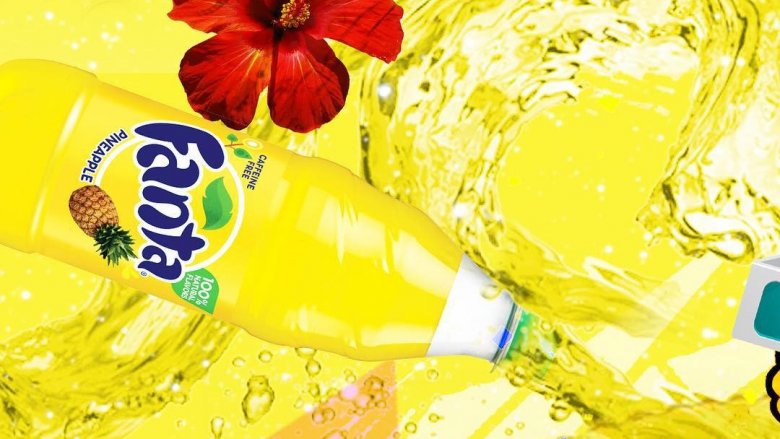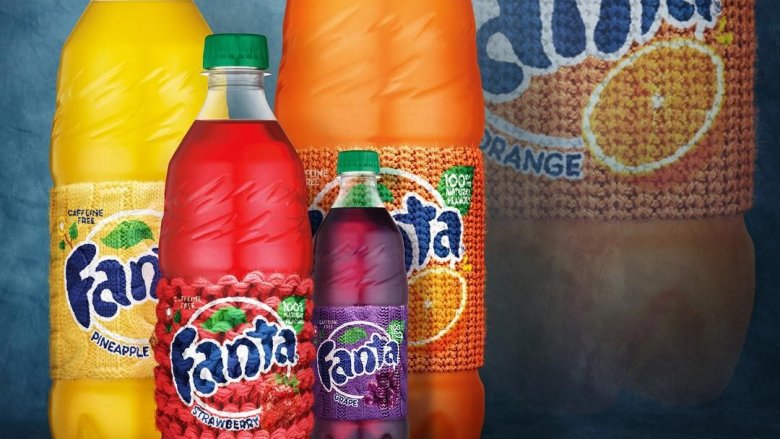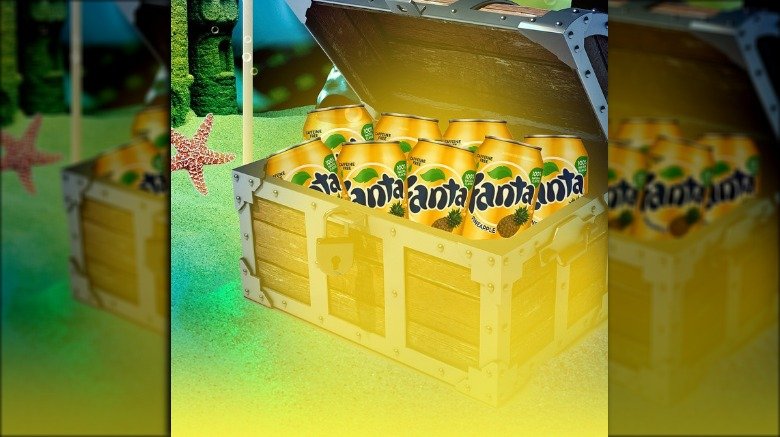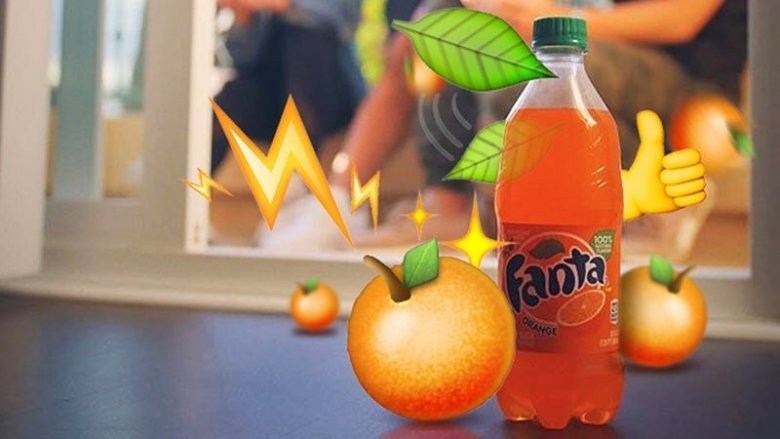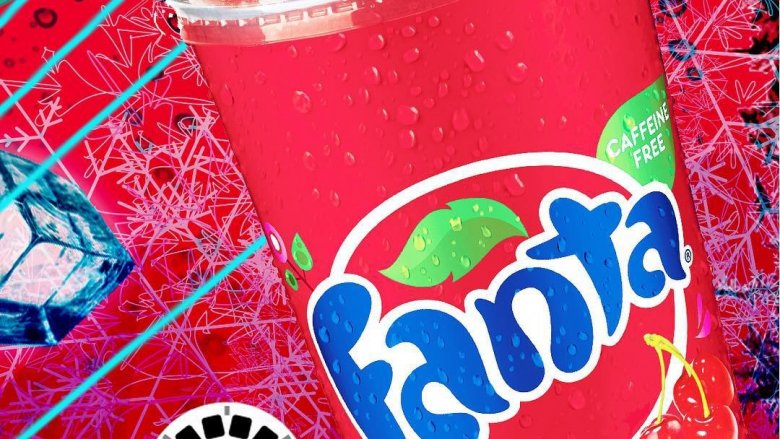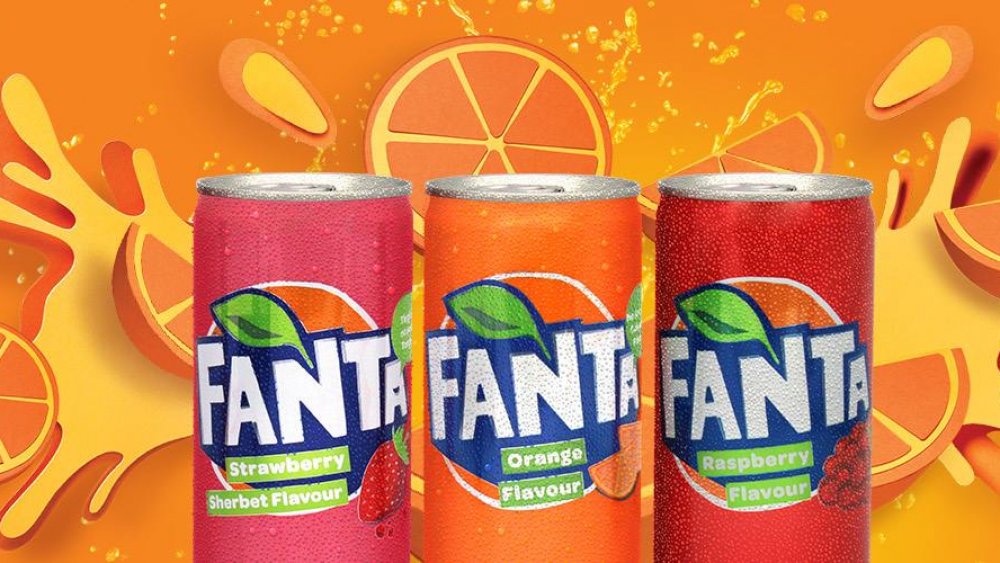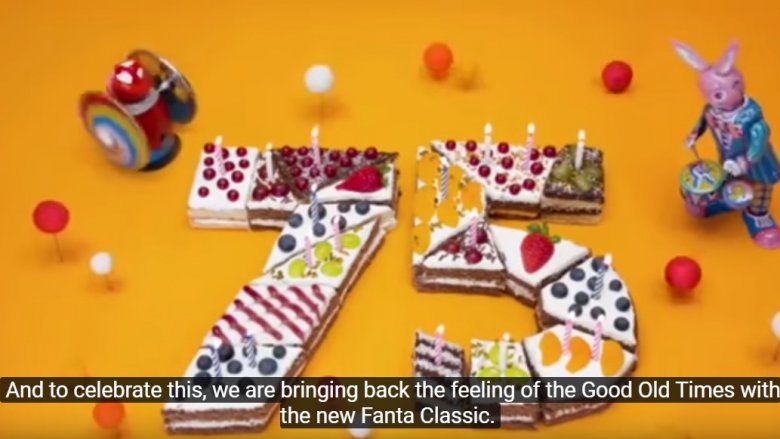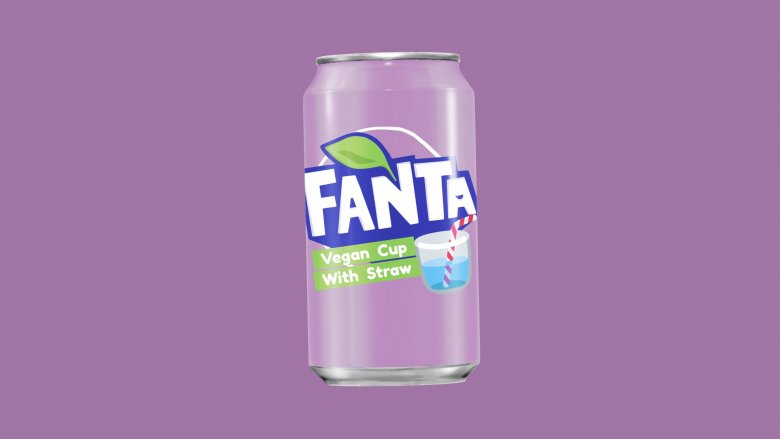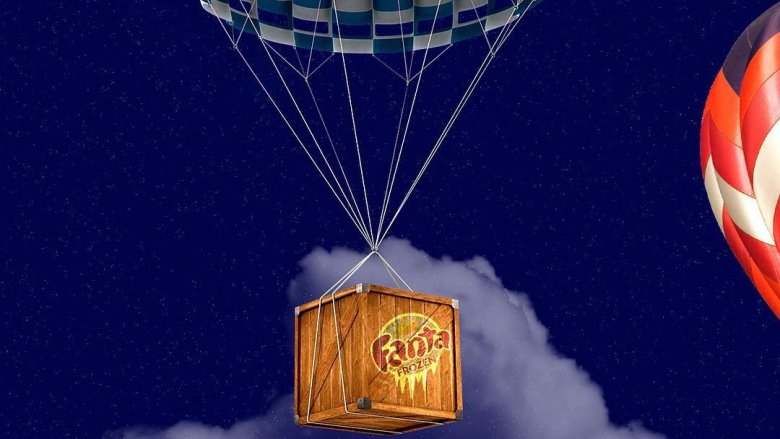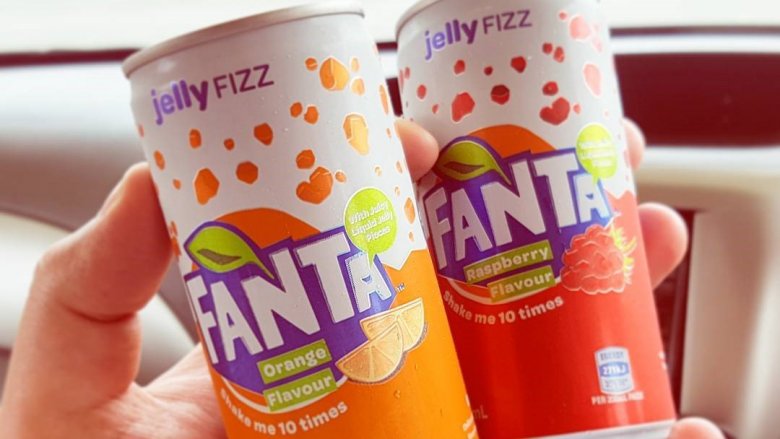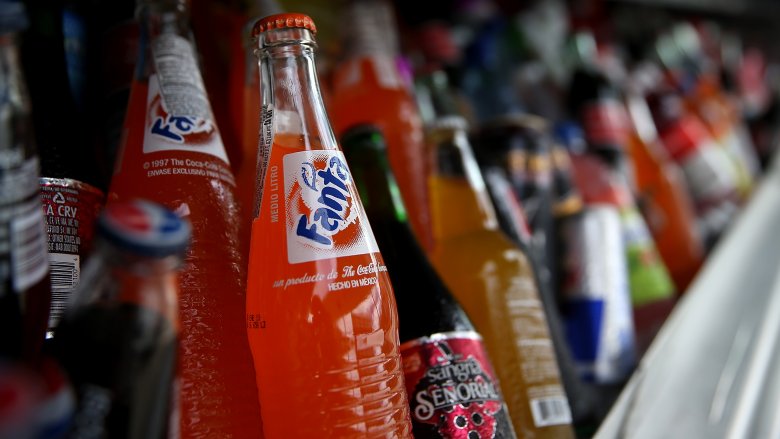The Untold Truth Of Fanta
Fanta is the only soda that can rival Faygo when it comes to fun flavors and fruitiness, and it's the label you gravitate toward when you're sick of the same-old colas and lemon lime. Even if you're not incredibly familiar with it, you've heard of it. While Faygo has their insane clowns, Fanta has their own catchy marketing gimmick. The Fantanas dance and sing what's possibly the most catchy, relentless jingle in marketing history... and more on that in a bit.
Fantas plays up fun and festive in all their marketing today, and that's certainly legit. But there's a ton of dark stuff in Fanta's history that seems at complete odds with the image they project today. There have been questionable marketing campaigns, weird attempts at reimagining what soda should be, and worst of all? It all started in Nazi Germany. Let's take a look at the wacky, weird, and disturbing story of Fanta.
It was made for Nazi Germany
At the beginning of the era of Nazi rule, Coca-Cola was the drink of the nation. They were so invested in Germany and the Nazis that they sponsored the 1936 Berlin Olympics, and were involved in honoring Hitler's 50th birthday. So, when Coca-Cola's US headquarters imposed an embargo on their German branch, Coca-Cola GmbH, after the bombing of Pearl Harbor in 1941, it was a huge deal.
With no more access to Coke's secret syrup, Coca-Cola GmbH needed a new product. That's when the branch's head, Max Keith, came up with the idea of developing a fizzy beverage just for the German market. It happened fast, too — by 1943, they had sold around 3 million cases of their new product, Fanta.
Historians (via Atlas Obscura) note there's an important distinction that needs to be made. Keith is considered a Nazi collaborator, not part of the party himself. Still, his Fanta saved the German branch of Coca-Cola from going under during the war years, and Fanta itself became a symbol of nationalist pride. Everyone in Nazi Germany drank Fanta, and production stopped with the end of the war.
The original flavor was pretty gross
Resources were scarce everywhere during the war years, and that meant people all over the world were doing the best they could with what little they had. That scarcity extended to even the largest corporations, and when Max Keith needed to come up with a sustainable formula for his new beverage, he had to use what he could get. That means the original Fanta was far different from the fruity, sweet drink you know today.
The basis of early Fanta was essentially waste products from other food industries, says Atlas Obscura. Now, picture this. If you've ever seen a cider press, you've seen the mashed apples, fibers, and cores that are left behind after they're crushed for juice. Take that, then add in the other major ingredient: whey. That's the liquid left behind after milk has curdled and been strained. That tasty combo was mixed with other things like beet sugar and various fruit shavings. Apparently, people loved it everyone drank it — but that couldn't have tasted good.
Modern Fanta started in Italy
We obviously don't drink apple-and-milk-byproduct Fanta today — fortunately — so how'd that happen?
Atlas Obscura says the production of original Fanta stopped in 1945 with the end of the war, and Keith was lauded for his ability to keep the company going. He came out the other side extremely well, and he was put in charge of Coca-Cola's European operations. Since he essentially built his career and reputation with help from Fanta, it's not entirely surprising that the fruit-based fizzy drink got a major makeover and a reintroduction to the market in 1955.
The relaunch happened in Naples, Italy, and Fanta's popularity was built on a pretty modern idea — sourcing local ingredients. That first flavor was orange, and it was made with all local citrus, says Coca-Cola. From there, it spread to the US and South Africa, then branched out into more than 190 different countries.
We may never know where it's name comes from
Fanta is an odd name, and there are actually two completely contradictory stories on just where the name came from. According to Atlas Obscura, Fanta was named by a salesman on Max Keith's team. Keith reportedly told them to come up with something creative, and it was Joe Knipp who suggested "Fanta" based on the idea of "fantasy." Makes sense, right? It was inspirational, it was imaginative, and it was exactly the sort of thing to capture an entire nation.
But the official story from Coca-Cola is very, very different, and it just sort of ignores Fanta's roots in a war-torn Germany. They say that Fanta wasn't named until it was released in Italy in 1955, and as a part of the release, they held a competition to come up with a name for the citrusy beverage. That's when they say Fanta was chosen, and the winning entry specified the word was derived from "fantasie," which means "imagination".
There are some unique international flavors
When Fanta first made the jump to the US, Coca-Cola says they came with their original orange flavor, along with strawberry, black cherry, lemon-lime, grape, root beer, ginger ale, and club soda. Those are pretty standard now, but head overseas and you'll find there are a ton of uniquely flavored Fantas developed to appeal to various regional tastes.
Some still sound pretty amazing to Americans, like Australia's Passionfruit Cream and Strawberry Sherbet. For years, Costa Rica was the only place you could find Fanta's Kolita, until it spread throughout Central America. Travels in Translation has made it a point to try all kinds of different versions of Fanta across the world, and they've found some that sound delicious, and some that sound just downright odd to American tastes. How about Japan's Peach, Orange-Cola, or Muscat?
There's also mango and sour apple versions in Hong Kong, anggur in Malaysia, Icy Lemon and Fruit Twist in the U.K., and Pomelo in the Netherlands. Those all sound great, so let's talk unconventional. How about Germany's elderflower-flavored Fanta? A curve ball, for sure. You can also find some of the wilder ones in Japan (via Napa Japan), like Okinawa Shikuwasa Fruit and Yogurt Tropical.
Their questionable 75th anniversary celebration
Sometimes, marketing campaigns are so shocking it's impossible to see just how so many people in the marketing department would have agreed to it. Fanta came up with one when they set about finding a way to celebrate their 75th anniversary in 2015.
Their campaign video explained how Fanta was developed at a time when resources were scarce, and people needed to get creative to make the most of what they had. That's absolutely true, but the video doesn't make it clear that the scarcity happened in Nazi Germany. The campaign went on to say that to celebrate Fanta's birthday, they were going to be releasing an original recipe version that would bring back "the feeling of the good old times."
Not surprisingly, it didn't take long before people were pointing out that those "good old times" were actually the Holocaust and the rise of the Third Reich. According to Fox, Coca-Cola said they were actually referring to their customers' childhood, but considering Digital Marketing Dawgs notes that the anniversary bottles were filled with a Fanta that was based on that 1940s-era drink, no one was buying it. Fanta pulled the ad.
This hilarious Fake Fanta Twitter bot
Inspiration can come from the most unlikely of places, just take the Twitter account Fake Fantas as an example. Fanta is known for its daring flavors, and this Twitter bot is adding some more. They're not real (yet), but some sound pretty good. Ice Cream Fanta, anyone? How about Modern Shaved Ice Fanta? Others are less-than-tasty sounding, and those are fake flavors like Ancient Sweat Drops Fanta, Eager Fried Shrimp Fanta, and Rotten Sandwich Fanta.
The Next Web wanted to find out just where this bot came from, so they talked to the programmer behind it. That's Spanish-born Laura Gonzalez, and her inspiration is just as odd as some of her flavors.
When she moved to the UK from Spain, she picked up a bottle of Fanta and found it wasn't the same drink she was used to. In the UK, Fanta is colored orange by extracts of pumpkin and carrot, and "Pumpkin and Carrot Fanta" struck her as incredibly funny. So, she scripted the bot and let it run wild. There's no word on whether or not Coca-Cola is monitoring it for good ideas, but they should be.
A Nigerian court ruled it's poisonous
In 2007, a Nigerian businessman named Fijabi Adebo imported Nigerian-made Fanta into his Manchester stores. The shipment was confiscated by customs before it got there, and when the contents of the bottles were tested, they were found unfit for human consumption under UK laws.
The BBC says the problem was with the amount of benzoic acid found in the soda. The chemical is a preservative, antifungal, and antibacterial, and the Nigerian recipe contains more than the amount allowed by UK standards. Alone, it's harmless, but when it's ingested along with vitamin C, it forms another compound linked to cancer.
There's actually a very good reason for the increased amount of benzoic acid in Nigerian Fanta: A hotter climate means more preservatives need to be used. After Fanta's Nigerian bottler refused to take responsibility for the destroyed shipment, Adebo sued. The courts found in his favor and instructed Fanta's bottler to include warning labels on the product, but the ruling was appealed.
Weirdly, it's not the first time Fanta has gotten in trouble over the benzene in their product. In 2007, Fanta's US division settled a case around Fanta Pineapple, when it was found the combination of vitamin C, sodium benzoate, and potassium benzoate was potentially dangerous (via NBC News).
Jelly Fizz Fanta is a thing
In 2017, Fanta went public with the news they were starting to release what they were calling a "multi-sensory" line of products.
It's even stranger than it sounds, and the first product — Jelly Fizz — launched first in Japan and Hong Kong about five years prior to the announcement that they were taking the idea global. It spread into Australia and New Zealand first, and "What is it?" is a completely legitimate question. Coca-Cola says it's essentially a soda that you shake before you open it, to release a "jelly fizziness." Fanta brand manager Josh Gonski had this to say about it: "It's like a delicious, liquid jelly. Soft drink blended with juicy liquid jelly pieces. You can't really explain it to someone..."
The Spinoff reviewed this weird beverage when it launched in New Zealand, and they were less than thrilled with the multi-sensory experience. They said, "...a line has been crossed and trust has been broken. Forever," and also noted that while it's kind of cool to shake a soda can, "Fanta Jelly Fizz looks and sounds like something that should only be happening in a deeply private space."
Why is their jingle so catchy?
So, do you want a Fanta? You're singing it now, aren't you?
Fanta has one of the catchiest jingles out there, and it's sung by The Fantanas. The group of dancers representing different Fanta flavors gets a regular overhaul (and in 2017, the first guy joined their line-up), but the jingle stays mostly the same. Don't ya wanta?
Inbound Marketing calls it one of the seven catchiest marketing jingles around, and there are a few things working together here to make it so darn catchy. LiveScience says most songs that get stuck in your head have a few things in common: they're simple, they're repetitive (in pitch, rhythm, or notes), and they're often at least vaguely annoying. Sounds familiar, right?
Marketing Wit says there are a ton of ways to make a jingle with an impact, and Fanta's song has it all. There are rhymes, up-tempo music, repetition, and best of all — for them — it includes the product name in the section that gets stuck in your head. That's the best marketing there is.
